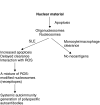Oxygen free radicals and systemic autoimmunity
- PMID: 12605691
- PMCID: PMC1808645
- DOI: 10.1046/j.1365-2249.2003.02104.x
Oxygen free radicals and systemic autoimmunity
Abstract
Reactive oxygen species generated during various metabolic and biochemical reactions have multifarious effects that include oxidative damage to DNA leading to various human degenerative and autoimmune diseases. The highly reactive hydroxy radical (*OH) can interact with chromatin and result in a wide range of sugar and base-derived products, DNA-protein cross-links and strand breaks. Studies from our laboratory have demonstrated that after modification the DNA becomes highly immunogenic and the induced antibodies exhibit variable antigen-binding characteristics. Systemic lupus erythematosus, a prototype autoimmune disease, is characterized by the presence of autoantibodies to multiple nuclear antigens. The detection of 8-hydroxyguanosine in the immune complex derived DNA of systemic lupus erythematosus patients reinforces the evidence that reactive oxygen species may be involved in its pathogenesis. Increased apoptosis and decreased clearance of apoptotic cells as observed in systemic lupus erythematosus (SLE) might well be a contributory factor in systemic autoimmunity. Clinically, titres of autoantibodies are closely related to the degree of renal inflammation. Anti-DNA antibodies may combine with circulating antigen and contribute to the deposition of immune complexes in renal glomeruli.
Figures
References
-
- Grisham MB. Reactive metabolites of oxygen and nitrogen in biology and medicine. Austin: RG Landes Co.; 1992.
-
- Nappi AJ, Vass E. Hydroxyl radical formation via iron-mediated Fenton Chemistry is inhibited by methylated catechols. Biochim Biophys Acta. 1998;1425:159–67. - PubMed
-
- Maddipati KR, Marnett LJ. Characterization of the major hydroperoxide-reducing activity of human plasma. Purification and properties of a selenium-dependent glutathione peroxidase. J Biol Chem. 1987;262:17398–403. - PubMed
-
- Lloyd RV, Hanna PM, Mason RP. The origin of the hydroxyl radical oxygen in the Fenton reaction. Free Rad Biol Med. 1997;22:885–8. - PubMed
Publication types
MeSH terms
Substances
LinkOut - more resources
Full Text Sources
Medical


